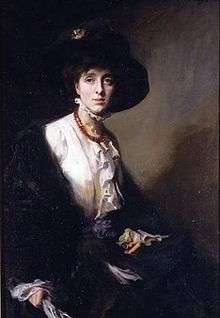Vita Sackville-West
| The Hon. Vita Sackville-West Lady Nicolson | |
|---|---|
|
Vita Sackville-West by Philip de László, 1910 | |
| Born |
9 March 1892 Knole House, Kent, England |
| Died |
2 June 1962 (aged 70) Sissinghurst Castle, Kent, England |
| Occupation | Novelist, poet, gardener |
| Nationality | UK |
| Period | 1917–1960 |
| Spouse | Harold Nicolson (m. 1913–62); 2 sons |
Victoria Mary Sackville-West, Lady Nicolson, CH (9 March 1892 – 2 June 1962), usually known as Vita Sackville-West, was an English poet, novelist, and garden designer. A successful and prolific novelist, poet, and journalist during her lifetime—she was twice awarded the Hawthornden Prize for Imaginative Literature: in 1927 for her pastoral epic, The Land, and in 1933 for her Collected Poems—today she is chiefly remembered for the celebrated garden at Sissinghurst she created with her diplomat husband, Sir Harold Nicolson. She is also remembered as the inspiration for the androgynous protagonist of the historical romp Orlando: A Biography, by her famous friend and admirer, Virginia Woolf, with whom she had a decade-long affair.[1]
Biography
Early life
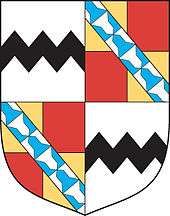
Victoria Sackville-West (known as "Vita") was born at Knole House near Sevenoaks, Kent, the only child of Victoria Sackville-West and Lionel Edward Sackville-West, 3rd Baron Sackville, who were cousins.[2] Her mother was the illegitimate daughter of Lionel Sackville-West, 2nd Baron Sackville and a Spanish dancer, Josefa de Oliva (née Durán y Ortega), known as Pepita. Christened Victoria Mary Sackville-West, the girl was known as "Vita" throughout her life to distinguish her from her mother.
The usual English aristocratic inheritance customs were followed by the Sackville-West family,[lower-alpha 1] which prevented Vita from inheriting Knole on the death of her father. The house followed the title, and was bequeathed instead by her father to his nephew Charles, who became the 4th Baron.
Marriage
In 1913, at age 21, Vita married the 27-year-old writer and politician Harold George Nicolson (21 November 1886 – 1 May 1968) in the private chapel at Knole. Nicknamed Hadji, or pilgrim, by his father, he was the third son of British diplomat Arthur Nicolson, 1st Baron Carnock (1849–1928). The couple had an open marriage. Both Sackville-West and her husband had same-sex relationships before and during their marriage, as did some of the people in the Bloomsbury Group of writers and artists, with many of whom they had connections.[5]
Following the pattern of his father's career, Harold Nicholson was at different times a diplomat, journalist, broadcaster, Member of Parliament, and author of biographies and novels. The couple lived for a number of years in Cihangir, a suburb of Constantinople (now Istanbul), and were present, in 1926, at the coronation of Rezā Shāh, in Tehran, Persia (now Iran). They returned to England in 1914 and bought Long Barn in Kent, where they lived from 1915 to 1930. They employed the architect Edwin Lutyens to make many improvements to the house.
The couple had two children: Nigel (1917–2004), who became a well-known editor, politician, and writer, and Benedict (1914–1978), an art historian. In the 1930s, the family acquired and moved to Sissinghurst Castle, near Cranbrook, Kent. Sissinghurst had once been owned by Vita's ancestors, which gave it a dynastic attraction to her after her father disinheriting her from Knole and his title.[2] There the couple created the famous gardens that are now run by the National Trust. Sackville-West felt a sense of loss in signing documents in 1947 relinquishing any claim on the property, as part of its transition to the National Trust. She wrote of the signing that it "nearly broke my heart, putting my signature to what I regarded as a betrayal of all the tradition of my ancestors and the house I loved."[6]
Career
Sackville-West was a writer and author of novels. The Edwardians (1930) and All Passion Spent (1931) are perhaps her best-known novels today. In the latter, the elderly Lady Slane courageously embraces a long suppressed sense of freedom and whimsy after a lifetime of convention. This novel was dramatised by the BBC in 1986 starring Dame Wendy Hiller. Her science-fantasy Grand Canyon (1942) is a "cautionary tale" (as she termed it) about a Nazi invasion of an unprepared United States. The book takes an unsuspected twist, however, that makes it something more than a typical invasion yarn.
In 1947 Sackville-West was made a Companion of Honour for her services to literature.[7] The same year she began a weekly column in The Observer called "In your Garden". In 1948 she became a founder member of the National Trust's garden committee.
She is less well known as a biographer. The most famous of those works is her biography of Saint Joan of Arc in the work of the same name. Additionally, she composed a dual biography of Saint Teresa of Ávila and Thérèse of Lisieux entitled The Eagle and the Dove, a biography of the author Aphra Behn, and a biography of her maternal grandmother, the Spanish dancer known as Pepita.
Sackville-West's long narrative poem, The Land, won the Hawthornden Prize in 1927. She won it again, becoming the only writer to do so, in 1933 with her Collected Poems.
Affairs
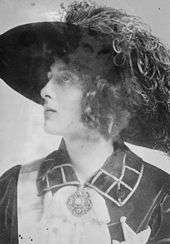
Rosamund Grosvenor
Vita's first close friend was Rosamund Grosvenor (5 September 1888 – 30 June 1944), who was four years her senior. She was the daughter of Algernon Henry Grosvenor (1864–1907), and the granddaughter of Robert Grosvenor, 1st Baron Ebury. Vita met Rosamund at Miss Woolf's school in 1899, when Rosamund had been invited to cheer Vita up while her father was fighting in the Second Boer War. Rosamund and Vita later shared a governess for their morning lessons. As they grew up together, Vita fell in love with Rosamund, whom she called 'Roddie' or 'Rose' or 'the Rubens lady'. Rosamund, in turn, was besotted with Vita. "Oh, I dare say I realized vaguely that I had no business to sleep with Rosamund, and I should certainly never have allowed anyone to find it out," she admits in her journal, but she saw no real conflict: "I really was innocent."[8]
Lady Sackville, Vita's mother, invited Rosamund to visit the family at their villa in Monte Carlo; Rosamund also stayed with Vita at Knole House, at Rue Lafitte, and at Sluie. During the Monte Carlo visit, Vita wrote in her diary, "I love her so much." Upon Rosamund's departure, Vita wrote, "Strange how little I minded [her leaving]; she has no personality, that's why."[8] Their secret relationship ended in 1913 when Vita married. Rosamund died in London in 1944 during a German V1 rocket raid.
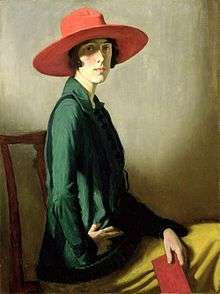
Violet Trefusis
Sackville-West was more deeply involved with Violet Trefusis, daughter of the Hon. George Keppel and his wife, Alice Keppel, a mistress of King Edward VII. They first met when Vita Sackville-West was 12 and Violet was 10, and attended school together for a number of years.
The relationship began when they were both in their teens and strongly influenced them for years. Both later married and became writers. Vita and Trefusis eloped several times from 1918 on, mostly to France. While there Sackville-West dressed as a man when they went out together. The affair ended badly. Both families were concerned that the women were creating scandal. Trefusis continued to pursue Sackville-West to great lengths until Sackville-West's affairs with other women finally took their toll.
The two women apparently made a bond to remain faithful to one another, meaning that although both were married, neither could engage in sexual relations with her own husband. Sackville-West, who already had two children by Nicholson, was prompted to end the affair when she heard allegations that Trefusis had been involved sexually with her own husband, indicating that she had broken their bond. Despite the rift, the two women were devoted to one another, and deeply in love. They continued to have occasional liaisons for a number of years afterwards, but never rekindled the affair.
Vita's novel Challenge also bears witness to this affair: Sackville-West and Trefusis had started writing this book as a collaborative endeavour, and the male character's name, Julian, had been Sackville-West's nickname when passing as a man. Her mother, Lady Sackville, found the portrayal obvious enough to refuse to allow publication of the novel in England; but Vita's son Nigel Nicolson (1973, p. 194) praises his mother: "She fought for the right to love, men and women, rejecting the conventions that marriage demands exclusive love, and that women should love only men, and men only women. For this she was prepared to give up everything… How could she regret that the knowledge of it should now reach the ears of a new generation, one so infinitely more compassionate than her own?"
Virginia Woolf

The affair for which Sackville-West is most remembered was in the late 1920s with the prominent writer Virginia Woolf. Woolf was inspired by Vita to write one of her most famous novels, Orlando, featuring a protagonist who changes sex over the centuries. This work was described by Sackville-West's son Nigel Nicolson as "the longest and most charming love-letter in literature."
Unusually, Woolf documented the moment of the conception of Orlando: she wrote in her diary on 5 October 1927: "And instantly the usual exciting devices enter my mind: a biography beginning in the year 1500 and continuing to the present day, called Orlando: Vita; only with a change about from one sex to the other" (excerpt from her diary published posthumously by her husband Leonard Woolf).
Other affairs
One of Vita's male suitors was Henry Lascelles who would later marry the Princess Royal and become the 6th Earl of Harewood.[9]
Vita Sackville-West also had a passionate affair between 1929 and 1931 with Hilda Matheson, head of the BBC Talks Department.[10] She called Hilda by the pet name of "Stoker" during their liaison.
In 1931, Sackville-West was in a ménage à trois with journalist Evelyn Irons, who had interviewed her after her novel The Edwardians was published and became a best-seller, and Irons's lover, Olive Rinder.[11][12]
Legacy
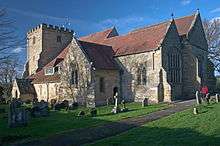
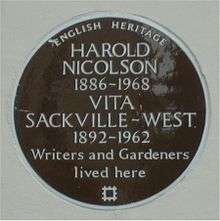
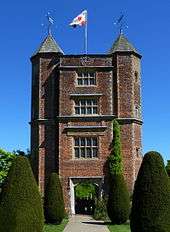
Vita Sackville-West died at Sissinghurst on 2 June 1962, aged 70. Sissinghurst Castle is now owned by the National Trust, given by Sackville-West's son Nigel to escape payment of inheritance taxes.[13]
A recording was made of Sackville-West reading from her poem The Land. This was on four 78rpm sides in the Columbia Records 'International Educational Society' Lecture series, Lecture 98 (Cat. no. D 40192/3).[14]
Writings
Poetry
- Chatterton (1909)
- A Dancing Elf (1912)
- Constantinople: Eight Poems (1915)
- Poems of West and East (1917)
- Orchard and Vineyard (1921)
- The Land (1927)
- King's Daughter (1929)
- Sissinghurst (1931)
- Invitation to Cast out Care (1931)
- Collected Poems: Volume 1 (1933)
- Solitude (1938)
- The Garden (1946)
Novels
- Heritage (1919)
- The Dragon in Shallow Waters (1921)
- The Heir (1922)
- Challenge (1923)
- Grey Wethers (1923)
- Seducers in Ecuador (1924)
- Passenger to Teheran (1926)
- The Edwardians (1930)
- All Passion Spent (1931)
- The Death of Noble Godavary and Gottfried Künstler (1932)
- Thirty Clocks Strike the Hour (1932)
- Family History (1932)
- The Dark Island (1934)
- Grand Canyon (1942)
- Devil at Westease (1947)
- The Easter Party (1953)
- No Signposts in the Sea (1961)
Translations
- Duineser Elegien: Elegies from the Castle of Duino, by Rainer Maria Rilke trns. V. Sackville-West (Hogarth Press, London, 1931)
Biographies and non-fiction
- "Aphra Behn: the Incomparable Astrea" (Gerald Howe 1927)
- Passenger to Teheran (Hogarth Press 1926, reprinted Tauris Parke Paperbacks 2007, ISBN 978-1-84511-343-8)
- Knole and the Sackvilles (1922)
- Saint Joan of Arc (Doubleday 1936, reprinted M. Joseph 1969)
- English Country Houses (William Collins, 1941, illustrated)
- Pepita (Doubleday, 1937, reprinted Hogarth Press 1970)
- The Eagle and The Dove (M. Joseph 1943)
- Twelve Days: an account of a journey across the Bakhtiari Mountains of South-western Persia (First published UK 1927; Doubleday Doran 1928; M. Haag 1987, reprinted Tauris Parke Paperbacks 2009 as Twelve Days in Persia)
- Sissinghurst: Vita Sackville-West and the Creation of a Garden (with Sarah Raven; St. Martin's Press 2014, ISBN 978-1-250-06005-1)
See also
Notes
- ↑ Technically, these are the Salic rules of agnatic male primogeniture.[3][4]
References
- ↑ In a letter to her son, Nigel Nicolson (Portrait of A Marriage), Vita Sackville-West wrote to her Nigel Nicolson that the physical component of her famous affair with Virginia Woolf had consisted of two occasions when they went to bed together and even then, they may have only engaged in "bundling", since Vita was aware of Woolf's extreme emotional fragility and did not want to cause her a mental breakdown with a tempestuously sexual affair. See Nigel Nicolson, Portrait of a Marriage (Chicago: University of Chicago Press, [reprint] 1998), p. 206.
- 1 2 Cannadine, David (1994). Aspects of Aristocracy: Grandeur and Decline in Modern Britain. New Haven, CT: Yale University Press. pp. 224–241. ISBN 0300059817. Retrieved 27 January 2013.
- ↑ Bell, Mathew. Inheritance: The Story of Knole and the Sackvilles, By Robert Sackville-West. 'The Independent', 16 May 2010;
- ↑ Hughes, Kathryn. "Love among the roses – Kathryn Hughes is touched by an unsentimental memoir", The Guardian', 27 September 2008.
- ↑ Glendinning, Victoria (1983). VITA. A Biography of Vita Sackville-West. New York: Alfred A. Knopf. p. 436.
- ↑ Tony Lord (2000). Gardening at Sissinghurst, Frances Lincoln & National Trust.
- ↑ "The London Gazette Issue 38161 published on the 30 December 1947. Page 31 of 42". London Gazette. 30 December 1947.
- 1 2 Nicolson, Nigel (1973). Portrait of a Marriage: Vita Sackville-West and Harold Nicolson. Chicago, IL: University of Chicago Press. pp. 29–30. ISBN 0226583570. Retrieved 27 January 2013.
- ↑ Sackville-West and 6th Earl of Harewood, sparknotes.com; accessed 17 October 2014.
- ↑ Charlotte Higgins "What can the origins of the BBC tell us about its future?", The Guardian, 15 April 2014
- ↑ Lewis, Paul (30 April 2000). "Obituaries". Evelyn Irons, War Reporter, Is Dead at 99. New York Times. Retrieved 15 January 2012.
- ↑ Brenner, Felix (25 April 2000). "Obituary: Evelyn Irons". The Independent (London). The Independent.
- ↑ "A happy return to manure". The Economist. 2 October 2008. Retrieved 2 October 2008.
- ↑ Catalogue of Columbia Records, Up to and including Supplement no. 252 (Columbia Graphophone Company, London September 1933), p. 375.
Sources
- Victoria Glendinning: Vita: The Life of V. Sackville-West, Weidenfeld & Nicolson, 1983
- Nigel Nicolson and Vita Sackville-West: Portrait of a Marriage, The University of Chicago Press, 1998. First published 1973. ISBN 0-226-58357-0
- Michael Carney, Stoker: The Life of Hilda Matheson, privately published, Llangynog, 1999
- Matthew Dennison: Behind the Mask: The Life of Vita Sackville-West, William Collins, published 9 October 2014[1]
Further reading
- Robert Cross and Ann Ravenscroft-Hulme: Vita Sackville-West: A Bibliography (Oak Knoll Press, 1999); ISBN 1-58456-004-5
- Dennison, Matthew: "Behind the Mask: The Life of Vita Sackville-West" (St. Martins, 2015); ISBN 978-1250033949
- Eberle, Iwona: Eve with a Spade: Women, Gardens, and Literature in the Nineteenth Century (Grin, 2011); ISBN 978-3-640-84355-8
- Peggy Wolf: Sternenlieder und Grabgesänge. Vita Sackville-West: Eine kommentierte Bibliographie der deutschsprachigen Veröffentlichungen von ihr und über sie 1930 – 2005. (Daphne-Verlag, Göttingen, 2006); ISBN 3-89137-041-5
External links
| Wikiquote has quotations related to: Vita Sackville-West |
- Fuller list of Vita Sackville-West's publications
- Portrait photos at npg.org.uk
- "Archival material relating to Vita Sackville-West". UK National Archives.
- Works by Vita Sackville-West at Project Gutenberg
- Works by or about Vita Sackville-West at Internet Archive
- Works by Vita Sackville-West at LibriVox (public domain audiobooks)

- ↑ Dennison, Matthew (19 October 2014). "Who was the real Vita Sackville-West". The Telegraph (UK). Retrieved 25 November 2015.
